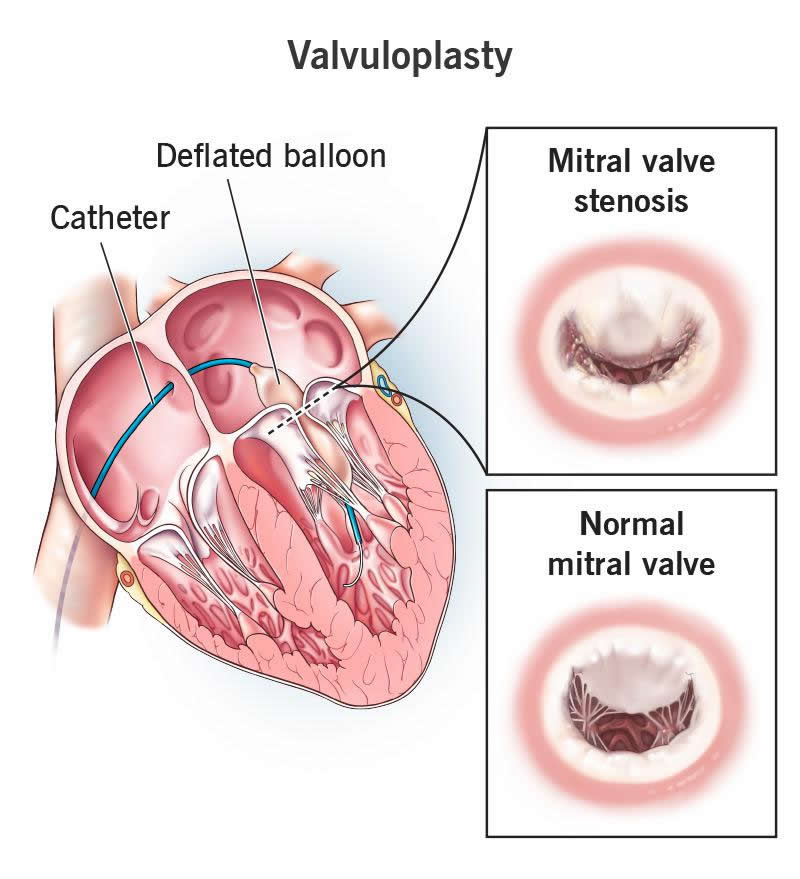Valvuloplasty
A valvuloplasty is a treatment to open a narrow heart valve. Instead of making surgical cuts, a healthcare provider goes through your blood vessel to reach your heart. This minimally invasive approach can lead to a quicker recovery and less pain. It’s also called balloon valvuloplasty because a balloon widens the valve opening.
Overview

What is valvuloplasty?
A valvuloplasty is a common procedure to make a heart valve opening bigger. Heart valves control how blood moves through your heart. A narrow valve may keep your heart from pumping blood well.
Another name for this treatment is balloon valvuloplasty. Your healthcare provider uses a small, hollow tube (catheter) with a balloon on it. This goes in your heart valve. When they put air in the balloon, it widens your valve.
You may also hear the name “valvotomy.” It can mean this procedure or the kind that uses open-heart surgery to get the same result.
What does this procedure treat?
Valvuloplasty can widen a heart valve that’s narrow (stenosis). A provider can use this for any of your four valves. The most common valvuloplasty is for mitral or aortic valves.
You may have valvotomy as a short-term repair. Later, you may get a new valve. Valvuloplasty isn’t the same thing as a heart valve replacement.
Treatment Details
How should I prepare for this procedure?
Your healthcare provider will tell you how to prepare for a valvuloplasty. You can expect to:
- Fast (not eat or drink) starting the night before.
- Stop taking anticoagulants when and if your provider tells you to.
- Leave any metal, jewelry or removable retainers at home.
At the hospital, your care team will give you medicine (anesthesia) to help you relax. You’re usually awake while they work.
What happens during valvuloplasty?
A cardiologist (heart expert) performs balloon valvuloplasty. It takes one hour or longer. During the procedure, your provider:
- Inserts a small, hollow tube called a sheath through a blood vessel in your groin, arm or shoulder
- Threads a catheter with a deflated balloon through the sheath
- Injects a contrast dye and uses imaging to guide the catheter to your heart valve
- Inflates the balloon to open the narrowed heart valve
- Deflates the balloon
- Removes the catheter and balloon
- Closes the entry point with small stitches or a special surgical glue
Sometimes, your team leaves the sheath in place for up to six hours. They may do this if you have bleeding risks or need to wait for blood-thinning medicine to wear off.
What are the potential benefits and risks of this procedure?
Valvuloplasty increases blood flow. It helps your heart work with less effort. This procedure may help you delay or avoid replacing a valve.
This is a minimally invasive procedure. Compared to open-heart surgery, the benefits of valvuloplasty can include:
- Faster recovery
- Less scarring
- Lower risk of problems
- Reduced pain
Risks of valvotomy may include:
- Allergic reaction to the dye
- Infection
- Bleeding
- Damage to a blood vessel or heart chamber
- Valve leak
- Potential harm to pregnant women and fetuses
- Narrowing of the valve again later
- Abnormal heart rhythms
- Heart attack
- Stroke
Your specific risk factors depend on your overall health. Your provider can help you understand all the risks of a valvuloplasty.
Recovery and Outlook
What happens after valvuloplasty?
After this treatment, you’ll go to a recovery area. You’ll have a bandage on the skin where the catheter went in.
If the catheter went through your groin, you’ll need to wait a few hours before bending your leg. You may lie in bed for about two to six hours.
You’ll need to drink plenty of water to flush the contrast dye from your body. While on bed rest, you’ll need to use a urinal or bedpan. You can usually get up and move several hours after a valvotomy. Most people go home the next day.
How long does it take to recover from valvuloplasty?
Recovery time depends on several factors, like your overall health and heart condition. You’ll need to avoid strenuous activity and swimming for about five to seven days.
Many people can return to work after a week. You may need to wait longer if your job involves physical activity. It may take up to eight weeks to get back to everything you usually do.
You’ll likely have a follow-up visit three to six months after the procedure. Then, you’ll see your provider once a year.
When should I call my healthcare provider?
After a valvotomy, call your provider right away if you have:
- Chest pain
- Chills or fever
- Dizziness or fainting (syncope)
- Drainage or bleeding at the insertion site
- Nausea or vomiting
- Pain or swelling that worsens
- Weight increase of more than 3 pounds in one day
Additional Common Questions
What is the survival rate for valvuloplasty?
Your survival rate depends on factors like how bad your valve is, which valve has an issue and what medical problems you have.
If you have this procedure for a pulmonary valve, you’ll likely live as long as people without this issue. Most people who have this procedure for their mitral valve are alive seven years later.
About half of the people who have this procedure on their aortic valve are alive one year later. This is why providers use a balloon valvuloplasty as a bridge to getting a new aortic valve.
A note from Wockr
It’s normal to feel nervous about a heart procedure, even one that’s not open-heart surgery. A valvuloplasty can help you delay getting a new heart valve. But it’s not the right option for everyone. Your healthcare provider can answer any questions you have about a balloon valvuloplasty.